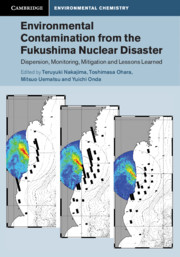 Environmental Contamination from the Fukushima Nuclear Disaster
Environmental Contamination from the Fukushima Nuclear Disaster from Part I - Transport of Radioactive Materials in the Environment
Published online by Cambridge University Press: 16 August 2019
Radioactive materials emitted from the Fukushima Daiichi Nuclear Power Station (FDNPS) were deposited on soils and trees in forested areas, agricultural land and urban areas. It is expected that the radioactively polluted soils and radioactive materials would spread through erosion of soils from mountains and rivers. In this chapter, we first examine the behaviour of radioactive materials deposited on the ground in upcountry districts. Second, we discuss the movement of radioactive materials from various types of flatlands and forests in mountainous areas based on their chemical forms in soils and on trees. Finally, we report on the accumulation and transfer of radioactive materials to vegetation such as trees.
To save this book to your Kindle, first ensure no-reply@cambridge.org is added to your Approved Personal Document E-mail List under your Personal Document Settings on the Manage Your Content and Devices page of your Amazon account. Then enter the ‘name’ part of your Kindle email address below. Find out more about saving to your Kindle.
Note you can select to save to either the @free.kindle.com or @kindle.com variations. ‘@free.kindle.com’ emails are free but can only be saved to your device when it is connected to wi-fi. ‘@kindle.com’ emails can be delivered even when you are not connected to wi-fi, but note that service fees apply.
Find out more about the Kindle Personal Document Service.
To save content items to your account, please confirm that you agree to abide by our usage policies. If this is the first time you use this feature, you will be asked to authorise Cambridge Core to connect with your account. Find out more about saving content to Dropbox.
To save content items to your account, please confirm that you agree to abide by our usage policies. If this is the first time you use this feature, you will be asked to authorise Cambridge Core to connect with your account. Find out more about saving content to Google Drive.